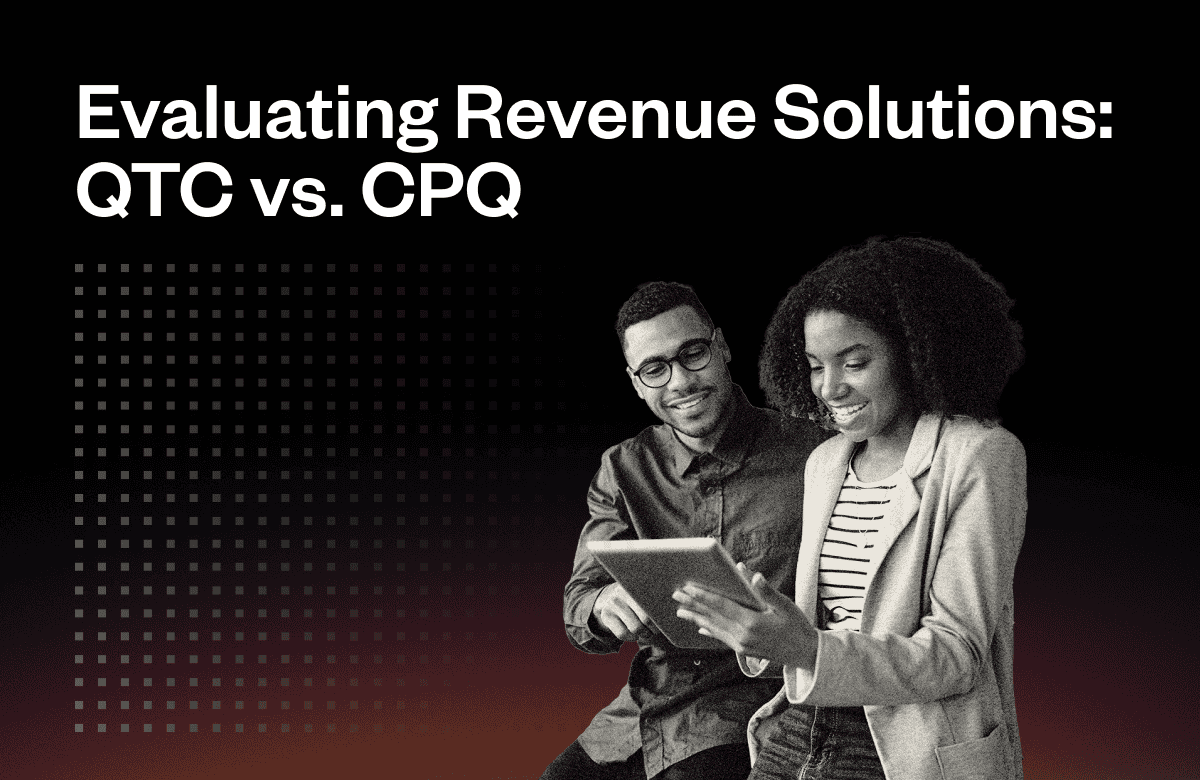If you’ve spent time in a fast-growing SaaS company then you already know that optimizing revenue generation and cash flow are almost always top priorities on any business leader’s KPIs sheet. However, lengthy product configuration discussions, manual pricing approvals, misaligned quotes, and orders, as well as delayed payments can hinder your sales cycle efficiency and make hitting these goals seemingly impossible.
Both quote-to-cash (QTC) and configure-price-quote (CPQ) platforms aim to address these bottlenecks that frustrate salespeople and negatively impact deals. But which one makes the most sense for your company?
Throughout this article, we’ll explain what QTC and CPQ solutions are, how they differ, their unique benefits and drawbacks, and specific scenarios where one option may prove better than the other.
Differences between quote-to-cash and CPQ
Quote-to-cash and CPQ (configure price quote) can be complementary software solutions that help companies drive revenue, though they serve different business processes.
Quote-to-cash refers to the entire life cycle of a customer from the moment an inquiry or quote comes in, through negotiation, ordering, fulfillment, and renewals. It manages the end-to-end workflow from revenue generation to revenue management, payment, and renewals.
CPQ, short for configure price quote software, focuses specifically on product configuration management and quoting, with cross-sell, upsell, and deal pricing optimization in real-time as key features. The main difference is that CPQ tends to be an embedded part of the quote-to-cash lifecycle that focuses on the product configuration and quoting experience—automating and optimizing that specific cross-sell/upsell revenue generation step for efficient order-to-cash operations.
Both play an important role in standardizing business processes and generating revenue but quote-to-cash takes a broader view across the customer journey.
Quote-to-cash process (QTC) defined
Quote-to-cash (QTC) refers to the end-to-end process that governs a customer’s journey from their initial engagement with your sales reps to revenue realization and renewal. QTC platforms manage the integrated workflows spanning marketing contacts, sales quotes, contracting, ordering, invoicing, collections, and maintaining ongoing customer relationships.
For example, when a prospect engages with a sales rep and requests a customized price quote, the QTC system steps in to guide product/service configuration conversations. It applies rules on pricing approvals, automatically generates proposal documents, and upon deal acceptance orchestrates the downstream order-to-cash operations from fulfillment to revenue recognition on the finance side. QTC unifies all required systems and data points—CRM, ERP, etc.—into a single automated workflow for each customer across their lifecycle.
Benefits of QTC
QTC solutions streamline business processes from deal creation to cash collection. Some of their key benefits include:
- Streamlines contract management and negotiation workflow: Automates contract drafting, approval routing, and version control for faster cycle times.
- Efficient order management for inventory and QTC process: Enables real-time inventory visibility and order orchestration from quote acceptance to fulfillment.
- Faster and more effective invoice process: Automates invoicing with flexible templates linked to contract terms for accuracy and speed.
- Streamlines entire sales cycle and operations: Provides a seamless workflow for the sales force from deal construction to order execution.
- Reduces customer churn rate: Increased efficiency, transparency, and compliance improves customer satisfaction and retention.
- Promotes pricing visibility for customers: Catalog, contract, and asset-based pricing rationalization provides accurate and accessible pricing.
The unified quote-to-cash platform enhances visibility, control, and coordination across the revenue lifecycle—accelerating deals while optimizing business operations.
Drawbacks of QTC
While providing significant process improvements, QTC also poses some implementation challenges, including:
- Implementing an efficient QTC process: Mapping and optimizing complex workflow touchpoints across sales, legal, finance, and operations.
- Integrating add-ons and workflows: Ensuring seamless connections with add-on tools for contract lifecycles, billing, reporting, and more.
- Demanding accurate quotes and invoices: Delivinger rigorous data governance and integrity required with little room for errors.
- Challenging pricing strategies: Requiring clear, consistent, and justified pricing for products, services, and deals.
- Scalability of automation: Evaluating infrastructure and capabilities to support the expansion of automated QTC processes.
Companies must strategically assess their organizational readiness along with software capabilities when managing the intricacies of an integrated quote-to-cash platform.
When to use QTC
Deciding between a configure-price-quote (CPQ) solution and a broader quote-to-cash (QTC) platform depends greatly on your business’ specific automation goals and operations complexity.
Companies that require deep accuracy in pricing for varied customer needs often benefit more from a QTC implementation than standalone CPQ software. The QTC system can incorporate all necessary pricing logic across products, assets, market conditions etc while optimizing the workflows used to construct personalized quotes and offers.
Similarly, businesses focused heavily on end-to-end process automation from initial quote to revenue recognition and renewals achieve greater efficiency gains from the broader QTC order lifecycle platform. The seamless connectivity into back-end financials and contract databases further improves cycle times.
Finally, companies with complex account management through integrated CRM systems gain more leverage from QTC as deal progress updates, account activity tracking, and order status communication remain fluid across customer-facing teams and back-office finance and fulfillment staff. The unified data and workflows help coordinate networks of people in addition to automating steps.
In essence, businesses with customized pricing guidelines, straight-through order processing needs and multifaceted customer relationships tend to benefit most from evaluating dedicated quote-to-cash solutions rather than singular CPQ tools in their technology landscapes.
Configure, price, quote (CPQ) defined
Configure, price, quote (CPQ) solutions streamline and optimize the creation of quotes and orders for customizable products or services by automatically applying pre-defined rules for configuration options, pricing models, and deal generation. Key capabilities include:
- Configure: CPQ tools build product or service variations, options, and component combinations that meet customer needs and organizational guidelines through guided selection processes and restriction rules. For example, a CPQ system would allow a sales rep to walk through PC configuration questions on memory, accessories, etc., and create valid equipment definitions.
- Price: Sophisticated pricing engines contained within CPQ platforms evaluate configurations, discount policies, volume levels, and other parameters for dynamic real-time price calculation. Pricing logic stays centralized but flexible for quotes.
- Quote: The quotes generated by CPQ systems provide customized product/service proposals, accurate pricing, descriptive names/codes, and other details needed to share with prospects and execute orders downstream upon acceptance. The documentation trails back to the specific configuration and pricing logic.
The integrated configure-price-quote functionality provides sales teams and customers a streamlined, accurate way to co-develop the perfect order while optimizing profitability through predefined rules and analytics.
Now that you have a high-level overview of these tools, let’s examine their benefits and drawbacks.
Benefits of CPQ
CPQ platforms build efficiency, accuracy, and speed into the sales process for configurable products and services. Some of CPQ software’s key benefits include:
- Improves customer relationships: Guided and optimized configuration conversations increase relevance while minimizing back-and-forth.
- Improved accuracy in deals: Rules-based automation minimizes errors in configurations and pricing.
- Provides faster sales cycles: Reduces time spent on manual product selection, pricing calculations, and quote creation.
By embedding industry and organizational intelligence into the quoting process, CPQ systems enable sales teams to have more strategic customer interactions – driving higher win rates, larger deal sizes, and accelerated cycles.
Drawbacks of CPQ
While it provides its users with a better quoting process, CPQ adoption has common challenges including:
- CPQ integrations are time-consuming: Connecting CPQ tools across CRM systems, ERPs, and other backends requires heavy IT effort.
- Proper training for the sales team: Adoption requires change management as sales teams adjust to new system-driven workflows.
- Cost of the tool and maintenance: Ongoing costs can present a barrier, especially for smaller companies.
- CPQ solutions scalability: Finding solutions to scale across geographies, products, deal types, and operationally can be difficult.
Companies should weigh business process disruption and complex integrations requiring technical skills against the efficiency gains from CPQ automation when budgeting implementation time, costs, and resources.
When to use CPQ
When assessing configure, price, and quote (CPQ) solutions versus wider quote-to-cash (QTC) platforms, companies should analyze where the greatest sales process constraints and complexity exist.
For many organizations, the front-end sales quoting stage for customizable deals proves most cumbersome. Lengthy product configuration discussions, compatibility assessments, pricing table analyses, and quote formulation bog down sales reps. This hinders efficiency and revenue growth. Purpose-built CPQ solutions directly address sales quoting bottlenecks through automated guidance on product selection, rules-based pricing, and streamlined proposal documentation. This not only accelerates deal completion but also enhances accuracy by reducing manual errors in configurations or discounted prices.
It further enables salespeople to spend more time on customer interactions versus internal quoting steps. The sales cycle and rep productivity optimization from CPQ can generate quick revenue growth and better customer configuration experiences. On the other hand, fuller quote-to-cash capabilities add extensive backend financial automation, contract management, and post-sales order processing that may overcomplicate sales motions rather than simplify them.
Companies seeing the greatest opportunities in fine-tuning the customer-facing quote experience itself can gain better traction from targeted CPQ tools. Evaluating where product intricacy and lost selling time drag on growth guides the solution choice.
Find & configure your best billing option
When evaluating SaaS accounting and operations solutions to optimize everything from your quoting through collections, you’ll need to decide between end-to-end quote-to-cash (QTC) systems versus more specialized configure-price-quote (CPQ) tools.
QTC solutions provide unification of financial processes under one umbrella—spanning marketing, sales operations like quoting, fulfillment, billing invoices, payments, and maintaining customer relationships. This integrated approach can maximize workflow efficiency, data continuity, and cross-departmental alignment. However, QTC requires heavy integration and process change management.
Alternatively, CPQ solutions focus deeply on enhancing the quote generation experience through rules-driven pricing, guided selling functionality, and streamlined proposal documentation. This directly accelerates quoting for sales teams. Yet CPQ tools need to seamlessly connect with downstream functions like contracts, invoicing, etc.
Ultimately, if you’re experiencing the greatest inefficiencies or loss of business during pre-order configuration and sales quoting stages, you may benefit most from targeted CPQ capabilities. However, if you need to connect decisions across departments surrounding a customer from acquisition to renewals, then you may want to invest in a QTC solution.
Want to start improving your quote-to-cash process before you start throwing your budget at these tools? Check out our Quote-to-Cash checklist—a comprehensive guide that’s designed to streamline your sales workflow and stop revenue leakage.




